Strategic Management: Prescriptive Approaches, SWOT, and Innovation
VerifiedAdded on 2023/06/14
|12
|3857
|201
Report
AI Summary
This report provides a comprehensive analysis of strategic management, focusing on the application of prescriptive and emergent approaches, a critical evaluation of SWOT analysis, and the role of innovation in driving long-term organizational development. The report contrasts prescriptive and emergent strategies, highlighting their respective advantages and disadvantages with examples, including Unilever Plc's strategic planning process. It critically evaluates the use of SWOT analysis, discussing its issues, limitations, and strategic importance, emphasizing its role in aligning resources with the environment. Furthermore, the report assesses the benefits, costs, and risks of using innovation for long-term growth, illustrating the practical application of strategy formulation and deployment with real-world examples.
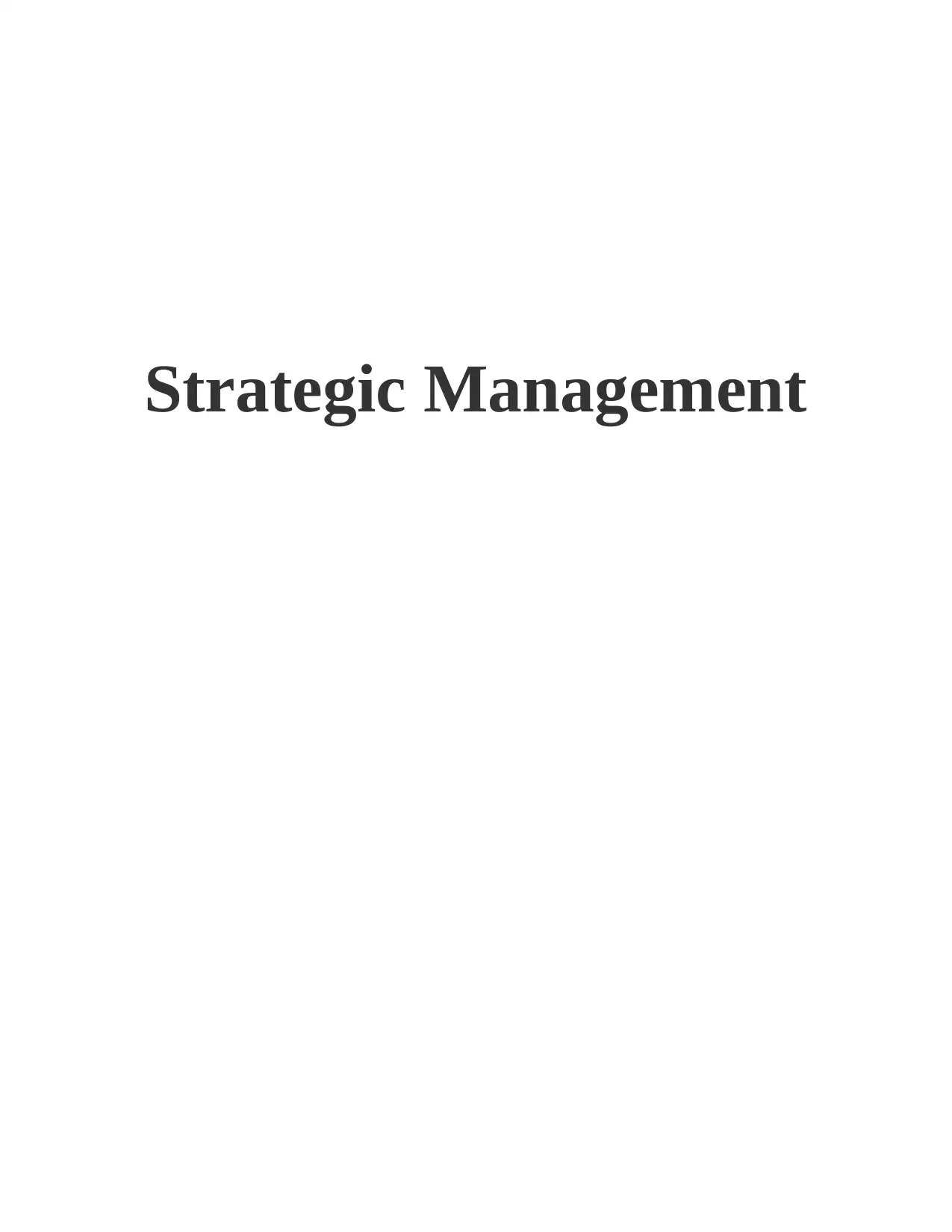
Strategic Management
Paraphrase This Document
Need a fresh take? Get an instant paraphrase of this document with our AI Paraphraser
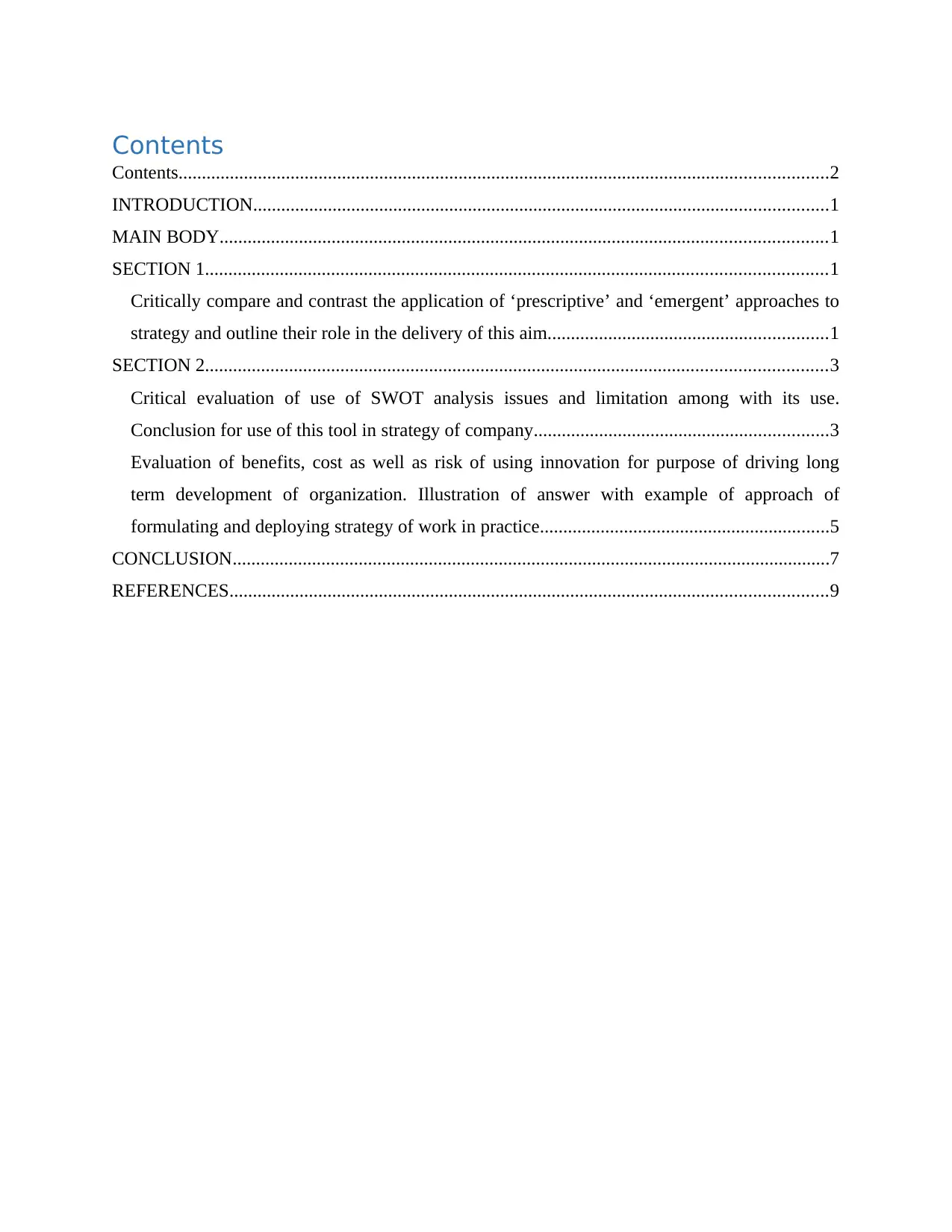
Contents
Contents...........................................................................................................................................2
INTRODUCTION...........................................................................................................................1
MAIN BODY..................................................................................................................................1
SECTION 1.....................................................................................................................................1
Critically compare and contrast the application of ‘prescriptive’ and ‘emergent’ approaches to
strategy and outline their role in the delivery of this aim............................................................1
SECTION 2.....................................................................................................................................3
Critical evaluation of use of SWOT analysis issues and limitation among with its use.
Conclusion for use of this tool in strategy of company...............................................................3
Evaluation of benefits, cost as well as risk of using innovation for purpose of driving long
term development of organization. Illustration of answer with example of approach of
formulating and deploying strategy of work in practice..............................................................5
CONCLUSION................................................................................................................................7
REFERENCES................................................................................................................................9
Contents...........................................................................................................................................2
INTRODUCTION...........................................................................................................................1
MAIN BODY..................................................................................................................................1
SECTION 1.....................................................................................................................................1
Critically compare and contrast the application of ‘prescriptive’ and ‘emergent’ approaches to
strategy and outline their role in the delivery of this aim............................................................1
SECTION 2.....................................................................................................................................3
Critical evaluation of use of SWOT analysis issues and limitation among with its use.
Conclusion for use of this tool in strategy of company...............................................................3
Evaluation of benefits, cost as well as risk of using innovation for purpose of driving long
term development of organization. Illustration of answer with example of approach of
formulating and deploying strategy of work in practice..............................................................5
CONCLUSION................................................................................................................................7
REFERENCES................................................................................................................................9

⊘ This is a preview!⊘
Do you want full access?
Subscribe today to unlock all pages.

Trusted by 1+ million students worldwide
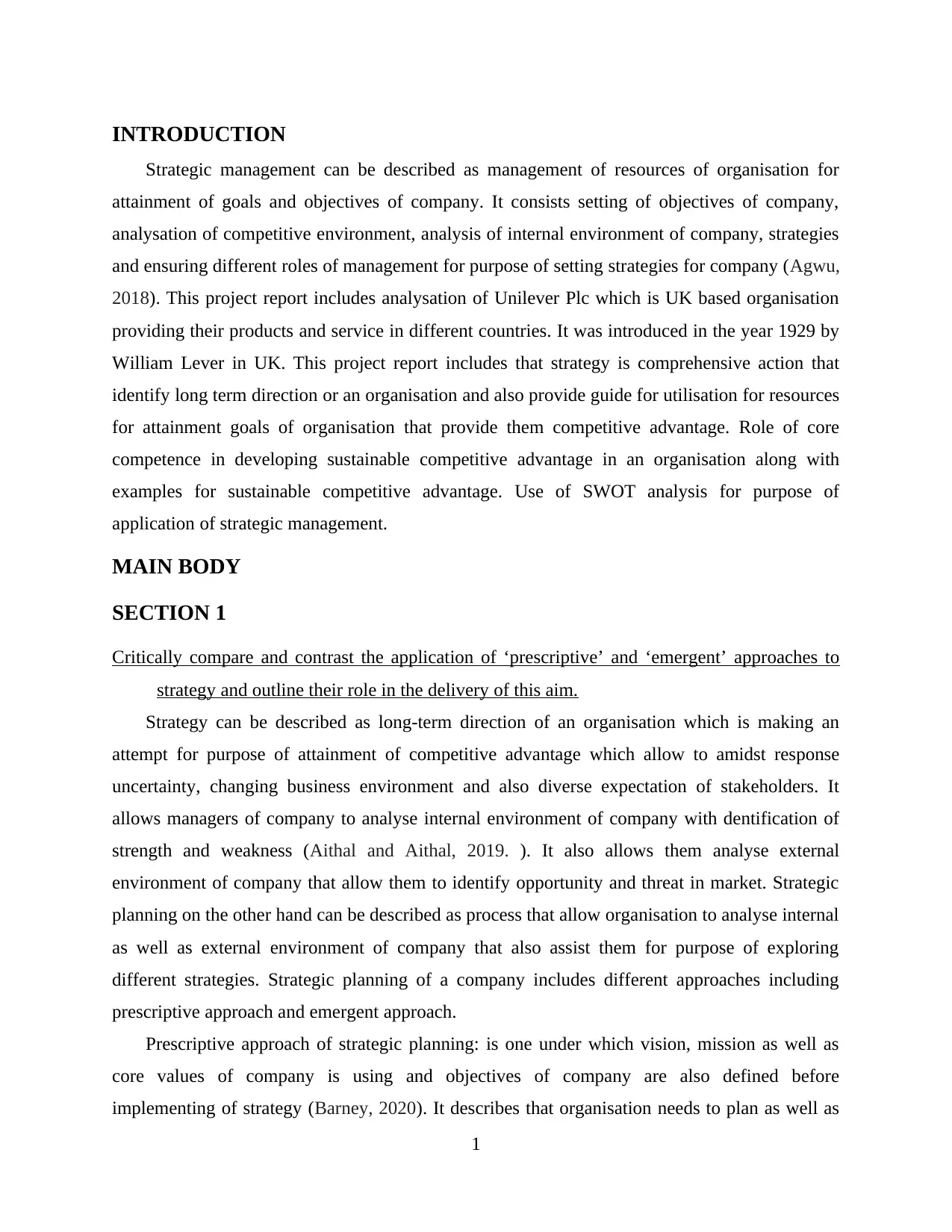
INTRODUCTION
Strategic management can be described as management of resources of organisation for
attainment of goals and objectives of company. It consists setting of objectives of company,
analysation of competitive environment, analysis of internal environment of company, strategies
and ensuring different roles of management for purpose of setting strategies for company (Agwu,
2018). This project report includes analysation of Unilever Plc which is UK based organisation
providing their products and service in different countries. It was introduced in the year 1929 by
William Lever in UK. This project report includes that strategy is comprehensive action that
identify long term direction or an organisation and also provide guide for utilisation for resources
for attainment goals of organisation that provide them competitive advantage. Role of core
competence in developing sustainable competitive advantage in an organisation along with
examples for sustainable competitive advantage. Use of SWOT analysis for purpose of
application of strategic management.
MAIN BODY
SECTION 1
Critically compare and contrast the application of ‘prescriptive’ and ‘emergent’ approaches to
strategy and outline their role in the delivery of this aim.
Strategy can be described as long-term direction of an organisation which is making an
attempt for purpose of attainment of competitive advantage which allow to amidst response
uncertainty, changing business environment and also diverse expectation of stakeholders. It
allows managers of company to analyse internal environment of company with dentification of
strength and weakness (Aithal and Aithal, 2019. ). It also allows them analyse external
environment of company that allow them to identify opportunity and threat in market. Strategic
planning on the other hand can be described as process that allow organisation to analyse internal
as well as external environment of company that also assist them for purpose of exploring
different strategies. Strategic planning of a company includes different approaches including
prescriptive approach and emergent approach.
Prescriptive approach of strategic planning: is one under which vision, mission as well as
core values of company is using and objectives of company are also defined before
implementing of strategy (Barney, 2020). It describes that organisation needs to plan as well as
1
Strategic management can be described as management of resources of organisation for
attainment of goals and objectives of company. It consists setting of objectives of company,
analysation of competitive environment, analysis of internal environment of company, strategies
and ensuring different roles of management for purpose of setting strategies for company (Agwu,
2018). This project report includes analysation of Unilever Plc which is UK based organisation
providing their products and service in different countries. It was introduced in the year 1929 by
William Lever in UK. This project report includes that strategy is comprehensive action that
identify long term direction or an organisation and also provide guide for utilisation for resources
for attainment goals of organisation that provide them competitive advantage. Role of core
competence in developing sustainable competitive advantage in an organisation along with
examples for sustainable competitive advantage. Use of SWOT analysis for purpose of
application of strategic management.
MAIN BODY
SECTION 1
Critically compare and contrast the application of ‘prescriptive’ and ‘emergent’ approaches to
strategy and outline their role in the delivery of this aim.
Strategy can be described as long-term direction of an organisation which is making an
attempt for purpose of attainment of competitive advantage which allow to amidst response
uncertainty, changing business environment and also diverse expectation of stakeholders. It
allows managers of company to analyse internal environment of company with dentification of
strength and weakness (Aithal and Aithal, 2019. ). It also allows them analyse external
environment of company that allow them to identify opportunity and threat in market. Strategic
planning on the other hand can be described as process that allow organisation to analyse internal
as well as external environment of company that also assist them for purpose of exploring
different strategies. Strategic planning of a company includes different approaches including
prescriptive approach and emergent approach.
Prescriptive approach of strategic planning: is one under which vision, mission as well as
core values of company is using and objectives of company are also defined before
implementing of strategy (Barney, 2020). It describes that organisation needs to plan as well as
1
Paraphrase This Document
Need a fresh take? Get an instant paraphrase of this document with our AI Paraphraser
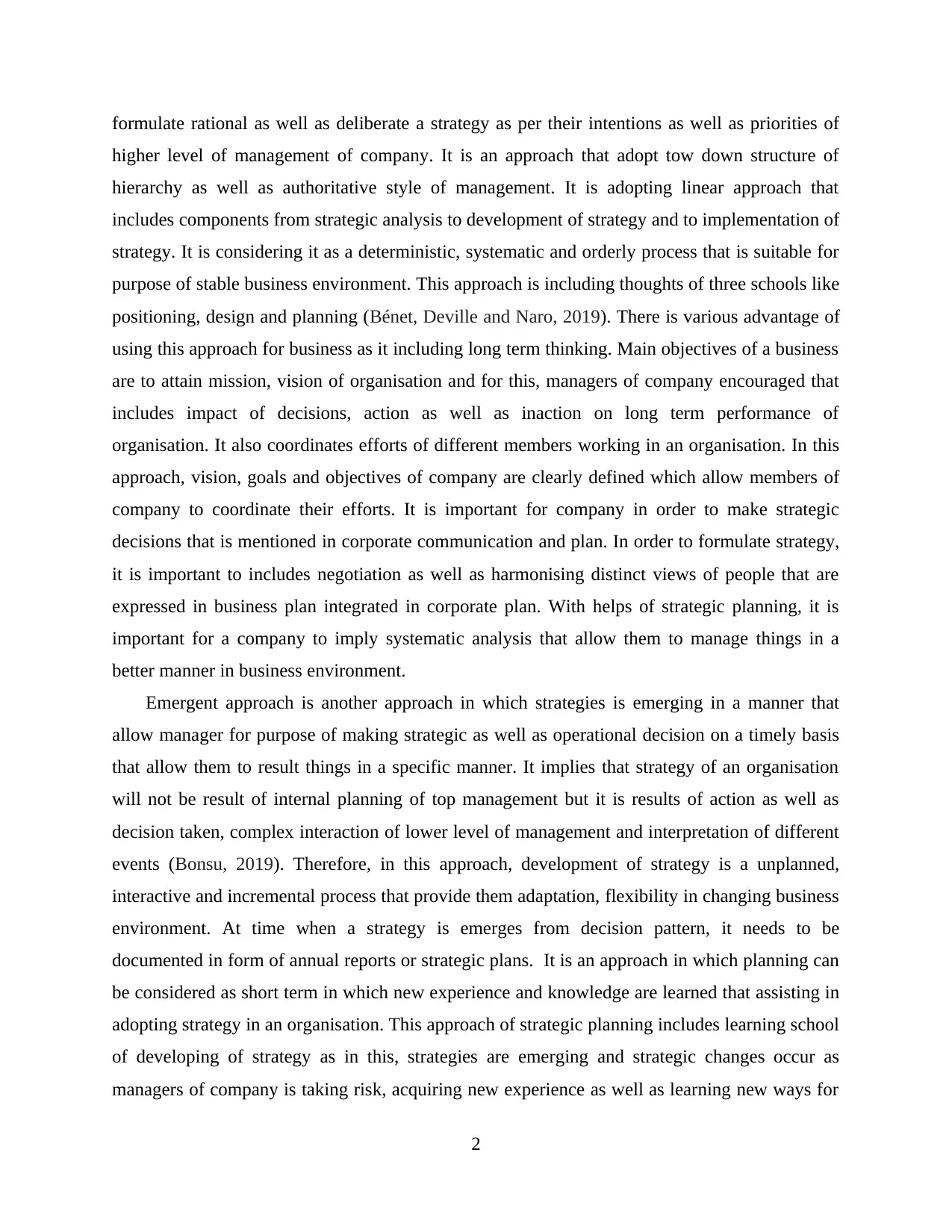
formulate rational as well as deliberate a strategy as per their intentions as well as priorities of
higher level of management of company. It is an approach that adopt tow down structure of
hierarchy as well as authoritative style of management. It is adopting linear approach that
includes components from strategic analysis to development of strategy and to implementation of
strategy. It is considering it as a deterministic, systematic and orderly process that is suitable for
purpose of stable business environment. This approach is including thoughts of three schools like
positioning, design and planning (Bénet, Deville and Naro, 2019). There is various advantage of
using this approach for business as it including long term thinking. Main objectives of a business
are to attain mission, vision of organisation and for this, managers of company encouraged that
includes impact of decisions, action as well as inaction on long term performance of
organisation. It also coordinates efforts of different members working in an organisation. In this
approach, vision, goals and objectives of company are clearly defined which allow members of
company to coordinate their efforts. It is important for company in order to make strategic
decisions that is mentioned in corporate communication and plan. In order to formulate strategy,
it is important to includes negotiation as well as harmonising distinct views of people that are
expressed in business plan integrated in corporate plan. With helps of strategic planning, it is
important for a company to imply systematic analysis that allow them to manage things in a
better manner in business environment.
Emergent approach is another approach in which strategies is emerging in a manner that
allow manager for purpose of making strategic as well as operational decision on a timely basis
that allow them to result things in a specific manner. It implies that strategy of an organisation
will not be result of internal planning of top management but it is results of action as well as
decision taken, complex interaction of lower level of management and interpretation of different
events (Bonsu, 2019). Therefore, in this approach, development of strategy is a unplanned,
interactive and incremental process that provide them adaptation, flexibility in changing business
environment. At time when a strategy is emerges from decision pattern, it needs to be
documented in form of annual reports or strategic plans. It is an approach in which planning can
be considered as short term in which new experience and knowledge are learned that assisting in
adopting strategy in an organisation. This approach of strategic planning includes learning school
of developing of strategy as in this, strategies are emerging and strategic changes occur as
managers of company is taking risk, acquiring new experience as well as learning new ways for
2
higher level of management of company. It is an approach that adopt tow down structure of
hierarchy as well as authoritative style of management. It is adopting linear approach that
includes components from strategic analysis to development of strategy and to implementation of
strategy. It is considering it as a deterministic, systematic and orderly process that is suitable for
purpose of stable business environment. This approach is including thoughts of three schools like
positioning, design and planning (Bénet, Deville and Naro, 2019). There is various advantage of
using this approach for business as it including long term thinking. Main objectives of a business
are to attain mission, vision of organisation and for this, managers of company encouraged that
includes impact of decisions, action as well as inaction on long term performance of
organisation. It also coordinates efforts of different members working in an organisation. In this
approach, vision, goals and objectives of company are clearly defined which allow members of
company to coordinate their efforts. It is important for company in order to make strategic
decisions that is mentioned in corporate communication and plan. In order to formulate strategy,
it is important to includes negotiation as well as harmonising distinct views of people that are
expressed in business plan integrated in corporate plan. With helps of strategic planning, it is
important for a company to imply systematic analysis that allow them to manage things in a
better manner in business environment.
Emergent approach is another approach in which strategies is emerging in a manner that
allow manager for purpose of making strategic as well as operational decision on a timely basis
that allow them to result things in a specific manner. It implies that strategy of an organisation
will not be result of internal planning of top management but it is results of action as well as
decision taken, complex interaction of lower level of management and interpretation of different
events (Bonsu, 2019). Therefore, in this approach, development of strategy is a unplanned,
interactive and incremental process that provide them adaptation, flexibility in changing business
environment. At time when a strategy is emerges from decision pattern, it needs to be
documented in form of annual reports or strategic plans. It is an approach in which planning can
be considered as short term in which new experience and knowledge are learned that assisting in
adopting strategy in an organisation. This approach of strategic planning includes learning school
of developing of strategy as in this, strategies are emerging and strategic changes occur as
managers of company is taking risk, acquiring new experience as well as learning new ways for
2
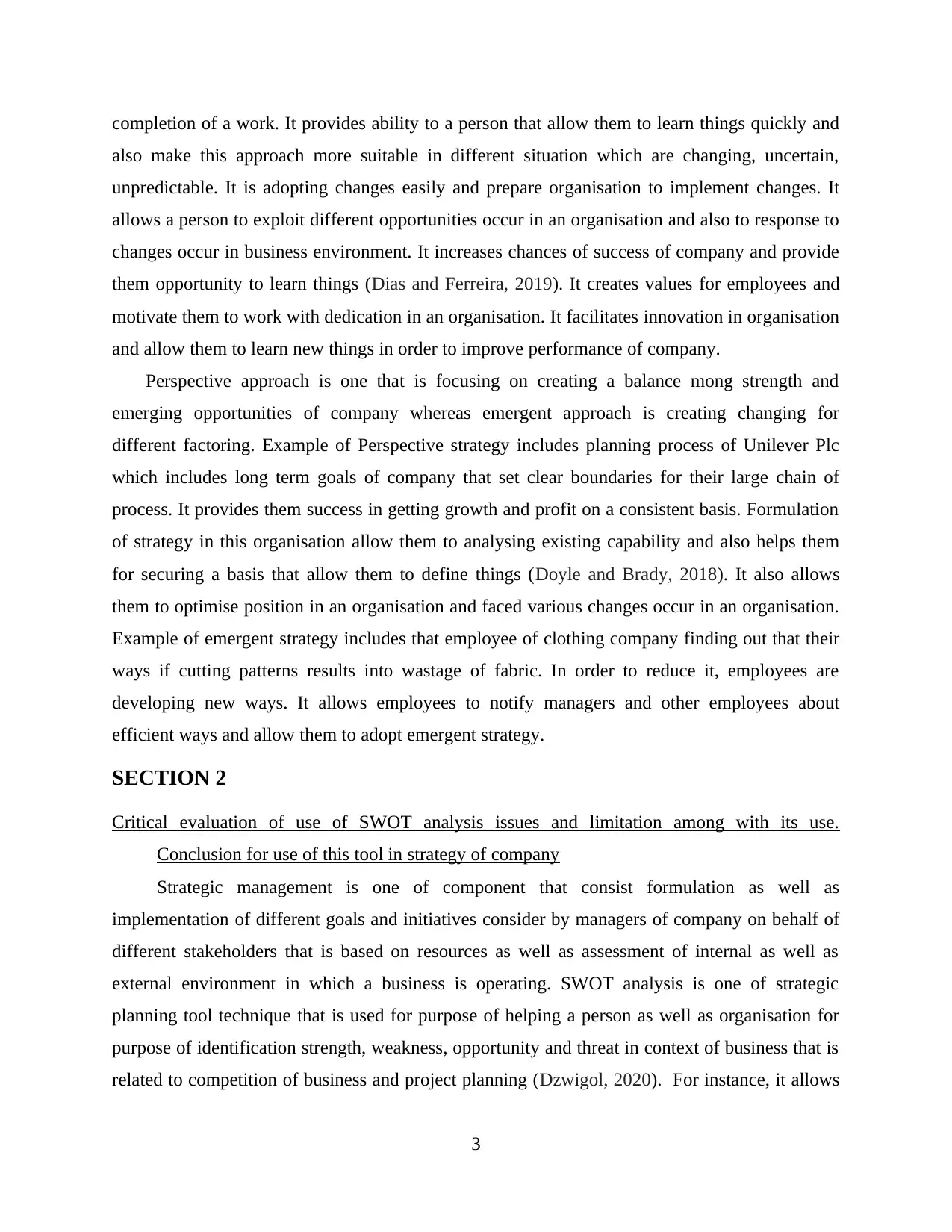
completion of a work. It provides ability to a person that allow them to learn things quickly and
also make this approach more suitable in different situation which are changing, uncertain,
unpredictable. It is adopting changes easily and prepare organisation to implement changes. It
allows a person to exploit different opportunities occur in an organisation and also to response to
changes occur in business environment. It increases chances of success of company and provide
them opportunity to learn things (Dias and Ferreira, 2019). It creates values for employees and
motivate them to work with dedication in an organisation. It facilitates innovation in organisation
and allow them to learn new things in order to improve performance of company.
Perspective approach is one that is focusing on creating a balance mong strength and
emerging opportunities of company whereas emergent approach is creating changing for
different factoring. Example of Perspective strategy includes planning process of Unilever Plc
which includes long term goals of company that set clear boundaries for their large chain of
process. It provides them success in getting growth and profit on a consistent basis. Formulation
of strategy in this organisation allow them to analysing existing capability and also helps them
for securing a basis that allow them to define things (Doyle and Brady, 2018). It also allows
them to optimise position in an organisation and faced various changes occur in an organisation.
Example of emergent strategy includes that employee of clothing company finding out that their
ways if cutting patterns results into wastage of fabric. In order to reduce it, employees are
developing new ways. It allows employees to notify managers and other employees about
efficient ways and allow them to adopt emergent strategy.
SECTION 2
Critical evaluation of use of SWOT analysis issues and limitation among with its use.
Conclusion for use of this tool in strategy of company
Strategic management is one of component that consist formulation as well as
implementation of different goals and initiatives consider by managers of company on behalf of
different stakeholders that is based on resources as well as assessment of internal as well as
external environment in which a business is operating. SWOT analysis is one of strategic
planning tool technique that is used for purpose of helping a person as well as organisation for
purpose of identification strength, weakness, opportunity and threat in context of business that is
related to competition of business and project planning (Dzwigol, 2020). For instance, it allows
3
also make this approach more suitable in different situation which are changing, uncertain,
unpredictable. It is adopting changes easily and prepare organisation to implement changes. It
allows a person to exploit different opportunities occur in an organisation and also to response to
changes occur in business environment. It increases chances of success of company and provide
them opportunity to learn things (Dias and Ferreira, 2019). It creates values for employees and
motivate them to work with dedication in an organisation. It facilitates innovation in organisation
and allow them to learn new things in order to improve performance of company.
Perspective approach is one that is focusing on creating a balance mong strength and
emerging opportunities of company whereas emergent approach is creating changing for
different factoring. Example of Perspective strategy includes planning process of Unilever Plc
which includes long term goals of company that set clear boundaries for their large chain of
process. It provides them success in getting growth and profit on a consistent basis. Formulation
of strategy in this organisation allow them to analysing existing capability and also helps them
for securing a basis that allow them to define things (Doyle and Brady, 2018). It also allows
them to optimise position in an organisation and faced various changes occur in an organisation.
Example of emergent strategy includes that employee of clothing company finding out that their
ways if cutting patterns results into wastage of fabric. In order to reduce it, employees are
developing new ways. It allows employees to notify managers and other employees about
efficient ways and allow them to adopt emergent strategy.
SECTION 2
Critical evaluation of use of SWOT analysis issues and limitation among with its use.
Conclusion for use of this tool in strategy of company
Strategic management is one of component that consist formulation as well as
implementation of different goals and initiatives consider by managers of company on behalf of
different stakeholders that is based on resources as well as assessment of internal as well as
external environment in which a business is operating. SWOT analysis is one of strategic
planning tool technique that is used for purpose of helping a person as well as organisation for
purpose of identification strength, weakness, opportunity and threat in context of business that is
related to competition of business and project planning (Dzwigol, 2020). For instance, it allows
3
⊘ This is a preview!⊘
Do you want full access?
Subscribe today to unlock all pages.

Trusted by 1+ million students worldwide
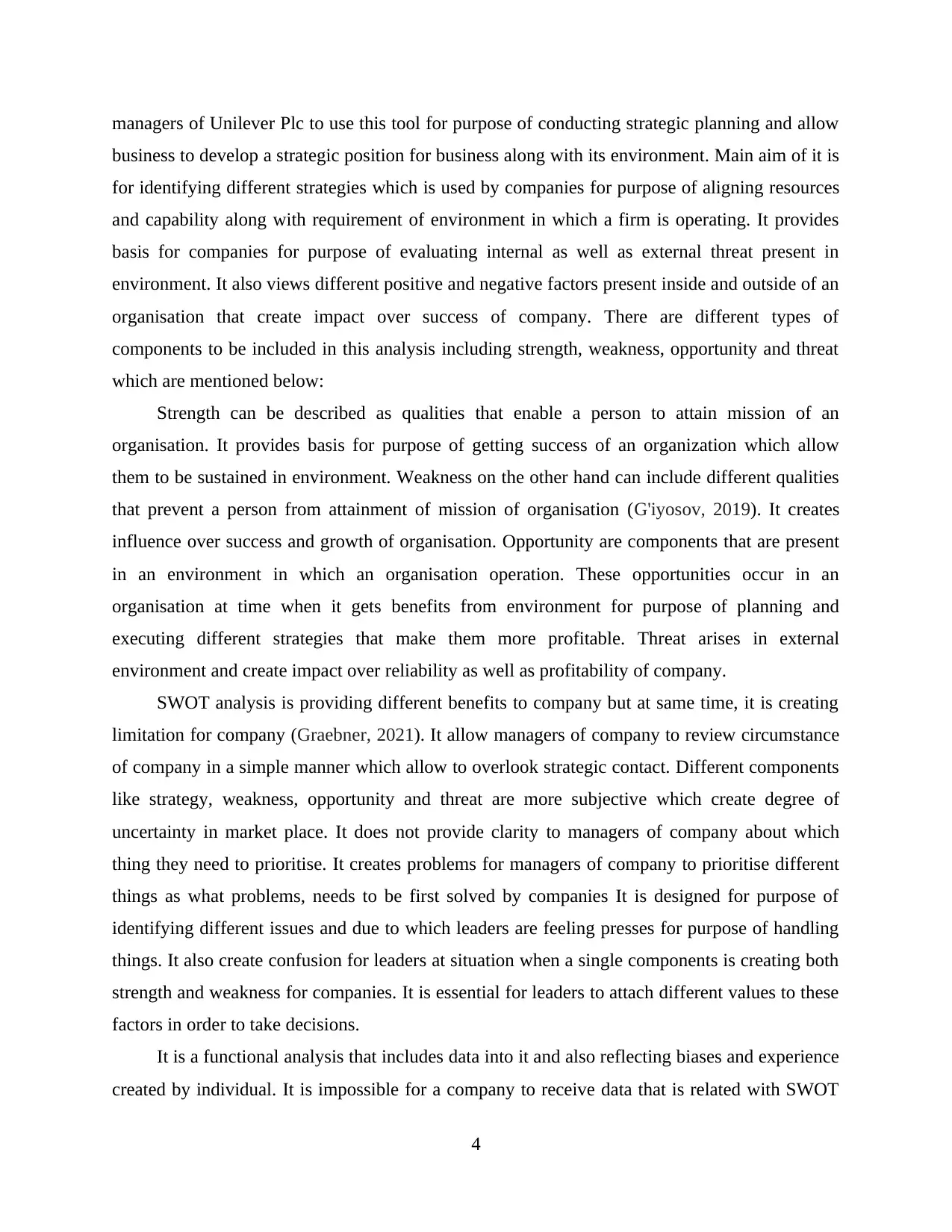
managers of Unilever Plc to use this tool for purpose of conducting strategic planning and allow
business to develop a strategic position for business along with its environment. Main aim of it is
for identifying different strategies which is used by companies for purpose of aligning resources
and capability along with requirement of environment in which a firm is operating. It provides
basis for companies for purpose of evaluating internal as well as external threat present in
environment. It also views different positive and negative factors present inside and outside of an
organisation that create impact over success of company. There are different types of
components to be included in this analysis including strength, weakness, opportunity and threat
which are mentioned below:
Strength can be described as qualities that enable a person to attain mission of an
organisation. It provides basis for purpose of getting success of an organization which allow
them to be sustained in environment. Weakness on the other hand can include different qualities
that prevent a person from attainment of mission of organisation (G'iyosov, 2019). It creates
influence over success and growth of organisation. Opportunity are components that are present
in an environment in which an organisation operation. These opportunities occur in an
organisation at time when it gets benefits from environment for purpose of planning and
executing different strategies that make them more profitable. Threat arises in external
environment and create impact over reliability as well as profitability of company.
SWOT analysis is providing different benefits to company but at same time, it is creating
limitation for company (Graebner, 2021). It allow managers of company to review circumstance
of company in a simple manner which allow to overlook strategic contact. Different components
like strategy, weakness, opportunity and threat are more subjective which create degree of
uncertainty in market place. It does not provide clarity to managers of company about which
thing they need to prioritise. It creates problems for managers of company to prioritise different
things as what problems, needs to be first solved by companies It is designed for purpose of
identifying different issues and due to which leaders are feeling presses for purpose of handling
things. It also create confusion for leaders at situation when a single components is creating both
strength and weakness for companies. It is essential for leaders to attach different values to these
factors in order to take decisions.
It is a functional analysis that includes data into it and also reflecting biases and experience
created by individual. It is impossible for a company to receive data that is related with SWOT
4
business to develop a strategic position for business along with its environment. Main aim of it is
for identifying different strategies which is used by companies for purpose of aligning resources
and capability along with requirement of environment in which a firm is operating. It provides
basis for companies for purpose of evaluating internal as well as external threat present in
environment. It also views different positive and negative factors present inside and outside of an
organisation that create impact over success of company. There are different types of
components to be included in this analysis including strength, weakness, opportunity and threat
which are mentioned below:
Strength can be described as qualities that enable a person to attain mission of an
organisation. It provides basis for purpose of getting success of an organization which allow
them to be sustained in environment. Weakness on the other hand can include different qualities
that prevent a person from attainment of mission of organisation (G'iyosov, 2019). It creates
influence over success and growth of organisation. Opportunity are components that are present
in an environment in which an organisation operation. These opportunities occur in an
organisation at time when it gets benefits from environment for purpose of planning and
executing different strategies that make them more profitable. Threat arises in external
environment and create impact over reliability as well as profitability of company.
SWOT analysis is providing different benefits to company but at same time, it is creating
limitation for company (Graebner, 2021). It allow managers of company to review circumstance
of company in a simple manner which allow to overlook strategic contact. Different components
like strategy, weakness, opportunity and threat are more subjective which create degree of
uncertainty in market place. It does not provide clarity to managers of company about which
thing they need to prioritise. It creates problems for managers of company to prioritise different
things as what problems, needs to be first solved by companies It is designed for purpose of
identifying different issues and due to which leaders are feeling presses for purpose of handling
things. It also create confusion for leaders at situation when a single components is creating both
strength and weakness for companies. It is essential for leaders to attach different values to these
factors in order to take decisions.
It is a functional analysis that includes data into it and also reflecting biases and experience
created by individual. It is impossible for a company to receive data that is related with SWOT
4
Paraphrase This Document
Need a fresh take? Get an instant paraphrase of this document with our AI Paraphraser
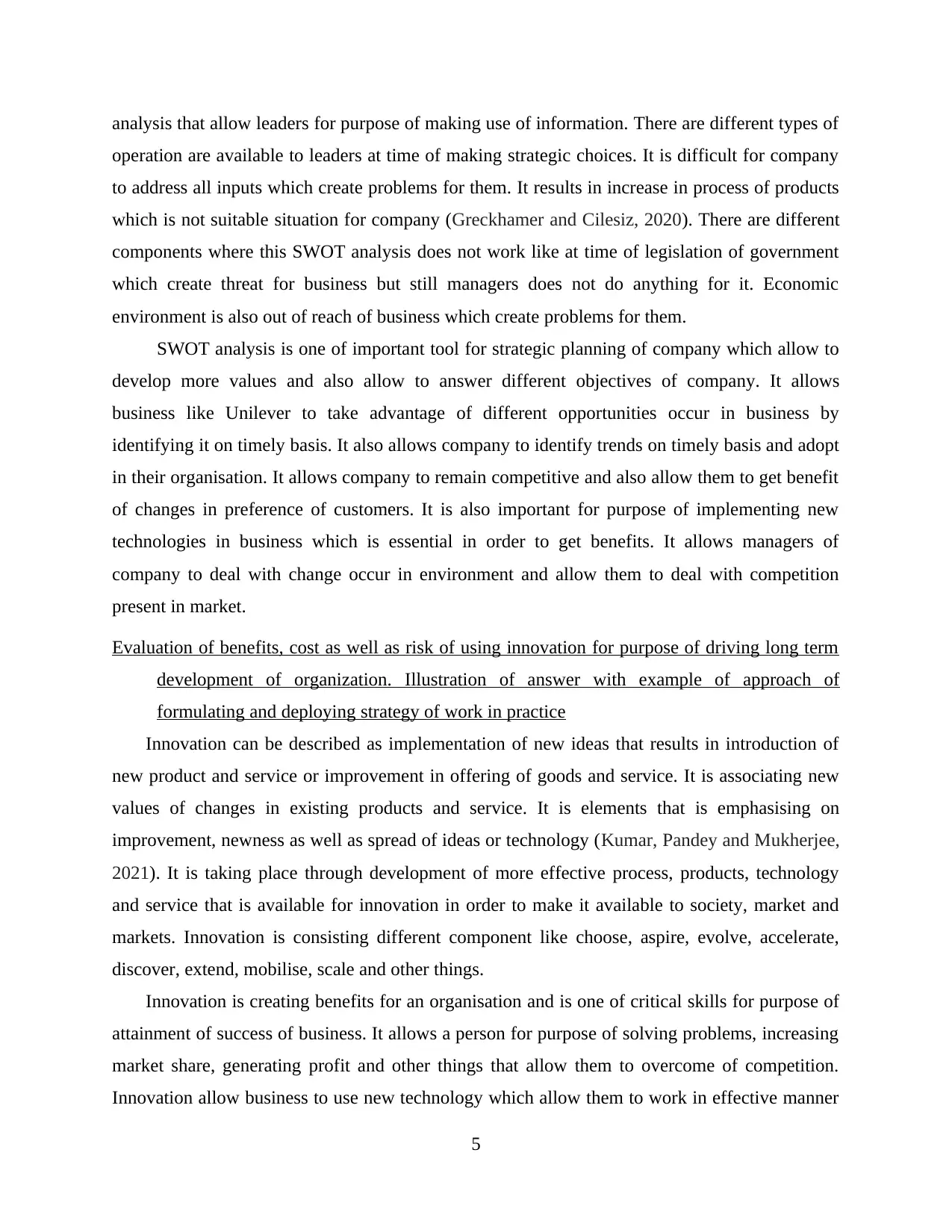
analysis that allow leaders for purpose of making use of information. There are different types of
operation are available to leaders at time of making strategic choices. It is difficult for company
to address all inputs which create problems for them. It results in increase in process of products
which is not suitable situation for company (Greckhamer and Cilesiz, 2020). There are different
components where this SWOT analysis does not work like at time of legislation of government
which create threat for business but still managers does not do anything for it. Economic
environment is also out of reach of business which create problems for them.
SWOT analysis is one of important tool for strategic planning of company which allow to
develop more values and also allow to answer different objectives of company. It allows
business like Unilever to take advantage of different opportunities occur in business by
identifying it on timely basis. It also allows company to identify trends on timely basis and adopt
in their organisation. It allows company to remain competitive and also allow them to get benefit
of changes in preference of customers. It is also important for purpose of implementing new
technologies in business which is essential in order to get benefits. It allows managers of
company to deal with change occur in environment and allow them to deal with competition
present in market.
Evaluation of benefits, cost as well as risk of using innovation for purpose of driving long term
development of organization. Illustration of answer with example of approach of
formulating and deploying strategy of work in practice
Innovation can be described as implementation of new ideas that results in introduction of
new product and service or improvement in offering of goods and service. It is associating new
values of changes in existing products and service. It is elements that is emphasising on
improvement, newness as well as spread of ideas or technology (Kumar, Pandey and Mukherjee,
2021). It is taking place through development of more effective process, products, technology
and service that is available for innovation in order to make it available to society, market and
markets. Innovation is consisting different component like choose, aspire, evolve, accelerate,
discover, extend, mobilise, scale and other things.
Innovation is creating benefits for an organisation and is one of critical skills for purpose of
attainment of success of business. It allows a person for purpose of solving problems, increasing
market share, generating profit and other things that allow them to overcome of competition.
Innovation allow business to use new technology which allow them to work in effective manner
5
operation are available to leaders at time of making strategic choices. It is difficult for company
to address all inputs which create problems for them. It results in increase in process of products
which is not suitable situation for company (Greckhamer and Cilesiz, 2020). There are different
components where this SWOT analysis does not work like at time of legislation of government
which create threat for business but still managers does not do anything for it. Economic
environment is also out of reach of business which create problems for them.
SWOT analysis is one of important tool for strategic planning of company which allow to
develop more values and also allow to answer different objectives of company. It allows
business like Unilever to take advantage of different opportunities occur in business by
identifying it on timely basis. It also allows company to identify trends on timely basis and adopt
in their organisation. It allows company to remain competitive and also allow them to get benefit
of changes in preference of customers. It is also important for purpose of implementing new
technologies in business which is essential in order to get benefits. It allows managers of
company to deal with change occur in environment and allow them to deal with competition
present in market.
Evaluation of benefits, cost as well as risk of using innovation for purpose of driving long term
development of organization. Illustration of answer with example of approach of
formulating and deploying strategy of work in practice
Innovation can be described as implementation of new ideas that results in introduction of
new product and service or improvement in offering of goods and service. It is associating new
values of changes in existing products and service. It is elements that is emphasising on
improvement, newness as well as spread of ideas or technology (Kumar, Pandey and Mukherjee,
2021). It is taking place through development of more effective process, products, technology
and service that is available for innovation in order to make it available to society, market and
markets. Innovation is consisting different component like choose, aspire, evolve, accelerate,
discover, extend, mobilise, scale and other things.
Innovation is creating benefits for an organisation and is one of critical skills for purpose of
attainment of success of business. It allows a person for purpose of solving problems, increasing
market share, generating profit and other things that allow them to overcome of competition.
Innovation allow business to use new technology which allow them to work in effective manner
5
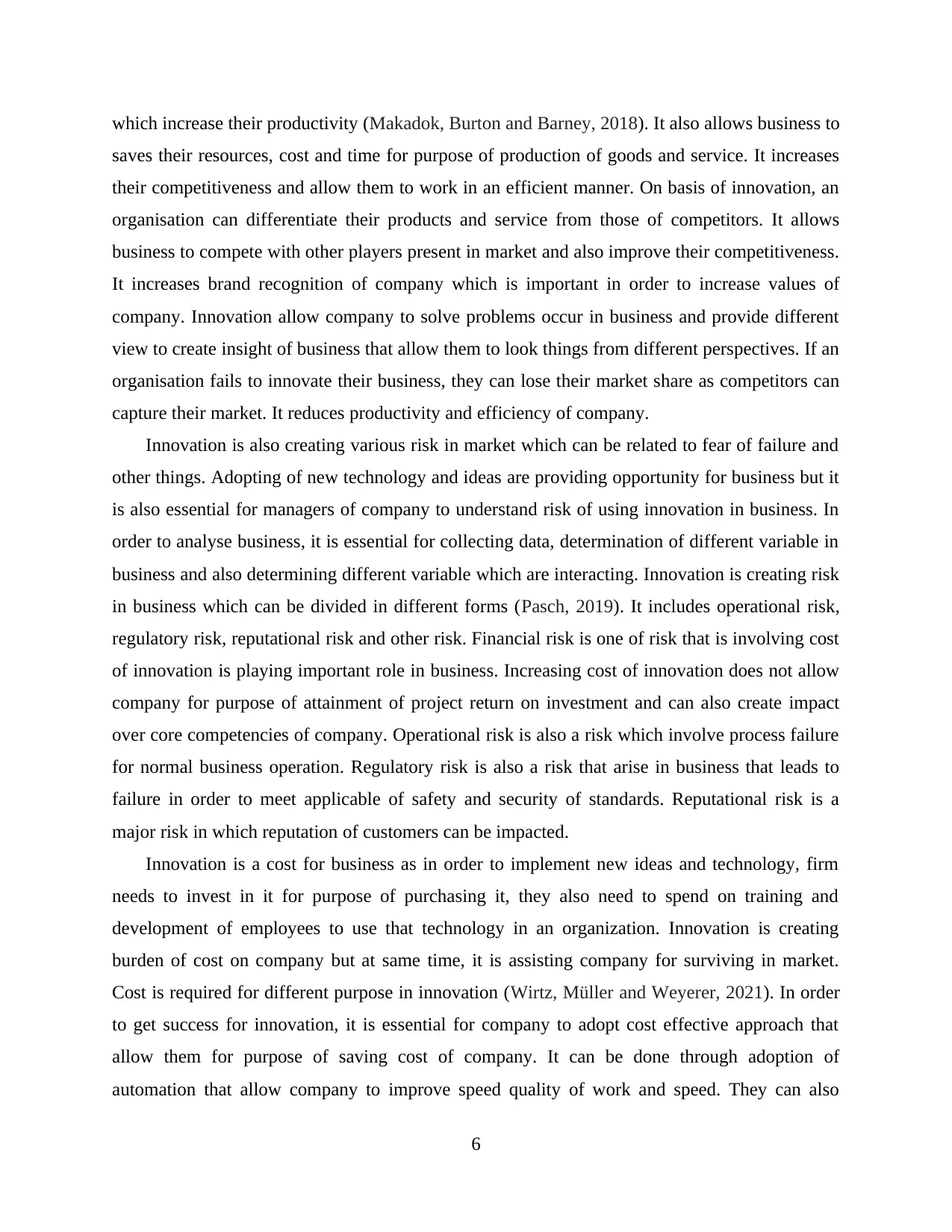
which increase their productivity (Makadok, Burton and Barney, 2018). It also allows business to
saves their resources, cost and time for purpose of production of goods and service. It increases
their competitiveness and allow them to work in an efficient manner. On basis of innovation, an
organisation can differentiate their products and service from those of competitors. It allows
business to compete with other players present in market and also improve their competitiveness.
It increases brand recognition of company which is important in order to increase values of
company. Innovation allow company to solve problems occur in business and provide different
view to create insight of business that allow them to look things from different perspectives. If an
organisation fails to innovate their business, they can lose their market share as competitors can
capture their market. It reduces productivity and efficiency of company.
Innovation is also creating various risk in market which can be related to fear of failure and
other things. Adopting of new technology and ideas are providing opportunity for business but it
is also essential for managers of company to understand risk of using innovation in business. In
order to analyse business, it is essential for collecting data, determination of different variable in
business and also determining different variable which are interacting. Innovation is creating risk
in business which can be divided in different forms (Pasch, 2019). It includes operational risk,
regulatory risk, reputational risk and other risk. Financial risk is one of risk that is involving cost
of innovation is playing important role in business. Increasing cost of innovation does not allow
company for purpose of attainment of project return on investment and can also create impact
over core competencies of company. Operational risk is also a risk which involve process failure
for normal business operation. Regulatory risk is also a risk that arise in business that leads to
failure in order to meet applicable of safety and security of standards. Reputational risk is a
major risk in which reputation of customers can be impacted.
Innovation is a cost for business as in order to implement new ideas and technology, firm
needs to invest in it for purpose of purchasing it, they also need to spend on training and
development of employees to use that technology in an organization. Innovation is creating
burden of cost on company but at same time, it is assisting company for surviving in market.
Cost is required for different purpose in innovation (Wirtz, Müller and Weyerer, 2021). In order
to get success for innovation, it is essential for company to adopt cost effective approach that
allow them for purpose of saving cost of company. It can be done through adoption of
automation that allow company to improve speed quality of work and speed. They can also
6
saves their resources, cost and time for purpose of production of goods and service. It increases
their competitiveness and allow them to work in an efficient manner. On basis of innovation, an
organisation can differentiate their products and service from those of competitors. It allows
business to compete with other players present in market and also improve their competitiveness.
It increases brand recognition of company which is important in order to increase values of
company. Innovation allow company to solve problems occur in business and provide different
view to create insight of business that allow them to look things from different perspectives. If an
organisation fails to innovate their business, they can lose their market share as competitors can
capture their market. It reduces productivity and efficiency of company.
Innovation is also creating various risk in market which can be related to fear of failure and
other things. Adopting of new technology and ideas are providing opportunity for business but it
is also essential for managers of company to understand risk of using innovation in business. In
order to analyse business, it is essential for collecting data, determination of different variable in
business and also determining different variable which are interacting. Innovation is creating risk
in business which can be divided in different forms (Pasch, 2019). It includes operational risk,
regulatory risk, reputational risk and other risk. Financial risk is one of risk that is involving cost
of innovation is playing important role in business. Increasing cost of innovation does not allow
company for purpose of attainment of project return on investment and can also create impact
over core competencies of company. Operational risk is also a risk which involve process failure
for normal business operation. Regulatory risk is also a risk that arise in business that leads to
failure in order to meet applicable of safety and security of standards. Reputational risk is a
major risk in which reputation of customers can be impacted.
Innovation is a cost for business as in order to implement new ideas and technology, firm
needs to invest in it for purpose of purchasing it, they also need to spend on training and
development of employees to use that technology in an organization. Innovation is creating
burden of cost on company but at same time, it is assisting company for surviving in market.
Cost is required for different purpose in innovation (Wirtz, Müller and Weyerer, 2021). In order
to get success for innovation, it is essential for company to adopt cost effective approach that
allow them for purpose of saving cost of company. It can be done through adoption of
automation that allow company to improve speed quality of work and speed. They can also
6
⊘ This is a preview!⊘
Do you want full access?
Subscribe today to unlock all pages.

Trusted by 1+ million students worldwide
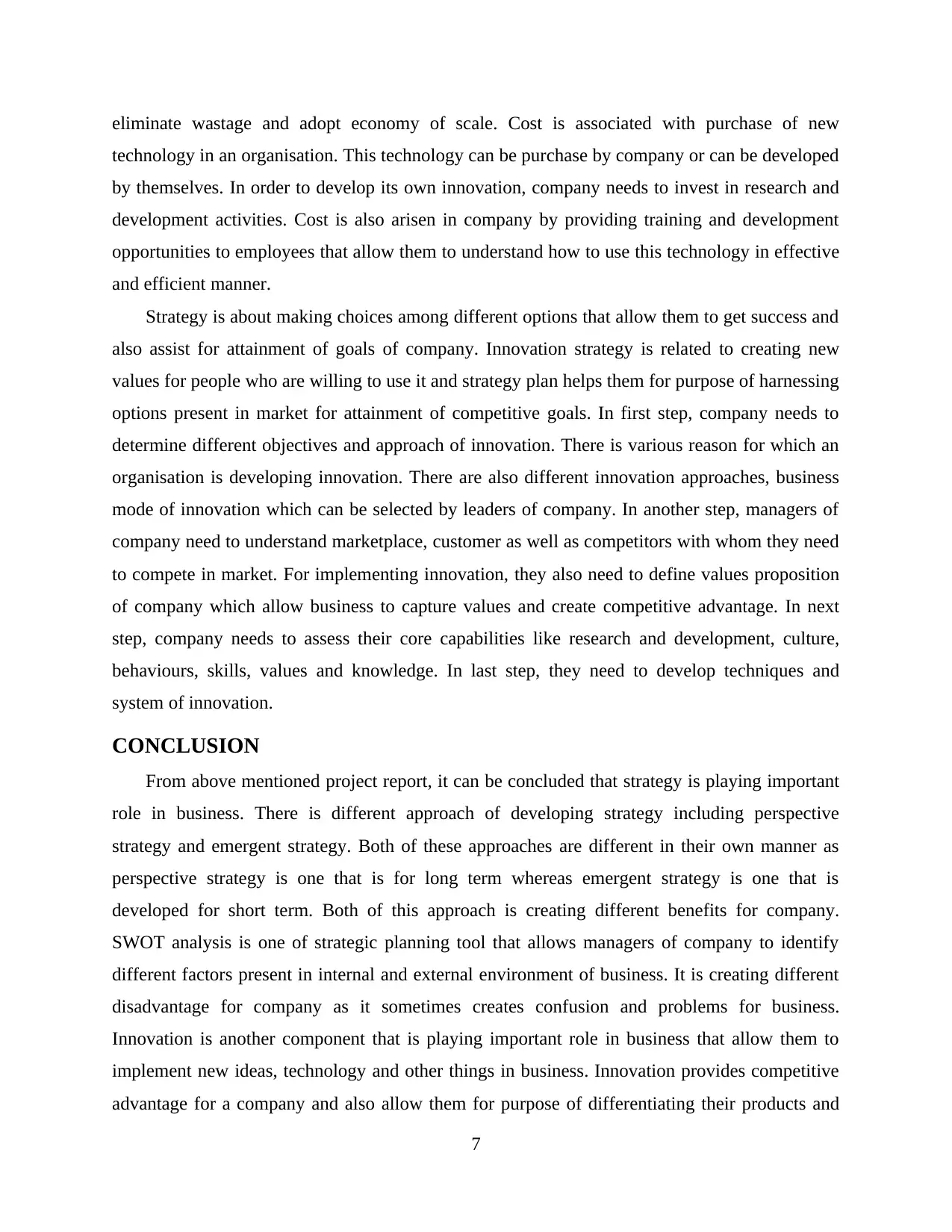
eliminate wastage and adopt economy of scale. Cost is associated with purchase of new
technology in an organisation. This technology can be purchase by company or can be developed
by themselves. In order to develop its own innovation, company needs to invest in research and
development activities. Cost is also arisen in company by providing training and development
opportunities to employees that allow them to understand how to use this technology in effective
and efficient manner.
Strategy is about making choices among different options that allow them to get success and
also assist for attainment of goals of company. Innovation strategy is related to creating new
values for people who are willing to use it and strategy plan helps them for purpose of harnessing
options present in market for attainment of competitive goals. In first step, company needs to
determine different objectives and approach of innovation. There is various reason for which an
organisation is developing innovation. There are also different innovation approaches, business
mode of innovation which can be selected by leaders of company. In another step, managers of
company need to understand marketplace, customer as well as competitors with whom they need
to compete in market. For implementing innovation, they also need to define values proposition
of company which allow business to capture values and create competitive advantage. In next
step, company needs to assess their core capabilities like research and development, culture,
behaviours, skills, values and knowledge. In last step, they need to develop techniques and
system of innovation.
CONCLUSION
From above mentioned project report, it can be concluded that strategy is playing important
role in business. There is different approach of developing strategy including perspective
strategy and emergent strategy. Both of these approaches are different in their own manner as
perspective strategy is one that is for long term whereas emergent strategy is one that is
developed for short term. Both of this approach is creating different benefits for company.
SWOT analysis is one of strategic planning tool that allows managers of company to identify
different factors present in internal and external environment of business. It is creating different
disadvantage for company as it sometimes creates confusion and problems for business.
Innovation is another component that is playing important role in business that allow them to
implement new ideas, technology and other things in business. Innovation provides competitive
advantage for a company and also allow them for purpose of differentiating their products and
7
technology in an organisation. This technology can be purchase by company or can be developed
by themselves. In order to develop its own innovation, company needs to invest in research and
development activities. Cost is also arisen in company by providing training and development
opportunities to employees that allow them to understand how to use this technology in effective
and efficient manner.
Strategy is about making choices among different options that allow them to get success and
also assist for attainment of goals of company. Innovation strategy is related to creating new
values for people who are willing to use it and strategy plan helps them for purpose of harnessing
options present in market for attainment of competitive goals. In first step, company needs to
determine different objectives and approach of innovation. There is various reason for which an
organisation is developing innovation. There are also different innovation approaches, business
mode of innovation which can be selected by leaders of company. In another step, managers of
company need to understand marketplace, customer as well as competitors with whom they need
to compete in market. For implementing innovation, they also need to define values proposition
of company which allow business to capture values and create competitive advantage. In next
step, company needs to assess their core capabilities like research and development, culture,
behaviours, skills, values and knowledge. In last step, they need to develop techniques and
system of innovation.
CONCLUSION
From above mentioned project report, it can be concluded that strategy is playing important
role in business. There is different approach of developing strategy including perspective
strategy and emergent strategy. Both of these approaches are different in their own manner as
perspective strategy is one that is for long term whereas emergent strategy is one that is
developed for short term. Both of this approach is creating different benefits for company.
SWOT analysis is one of strategic planning tool that allows managers of company to identify
different factors present in internal and external environment of business. It is creating different
disadvantage for company as it sometimes creates confusion and problems for business.
Innovation is another component that is playing important role in business that allow them to
implement new ideas, technology and other things in business. Innovation provides competitive
advantage for a company and also allow them for purpose of differentiating their products and
7
Paraphrase This Document
Need a fresh take? Get an instant paraphrase of this document with our AI Paraphraser
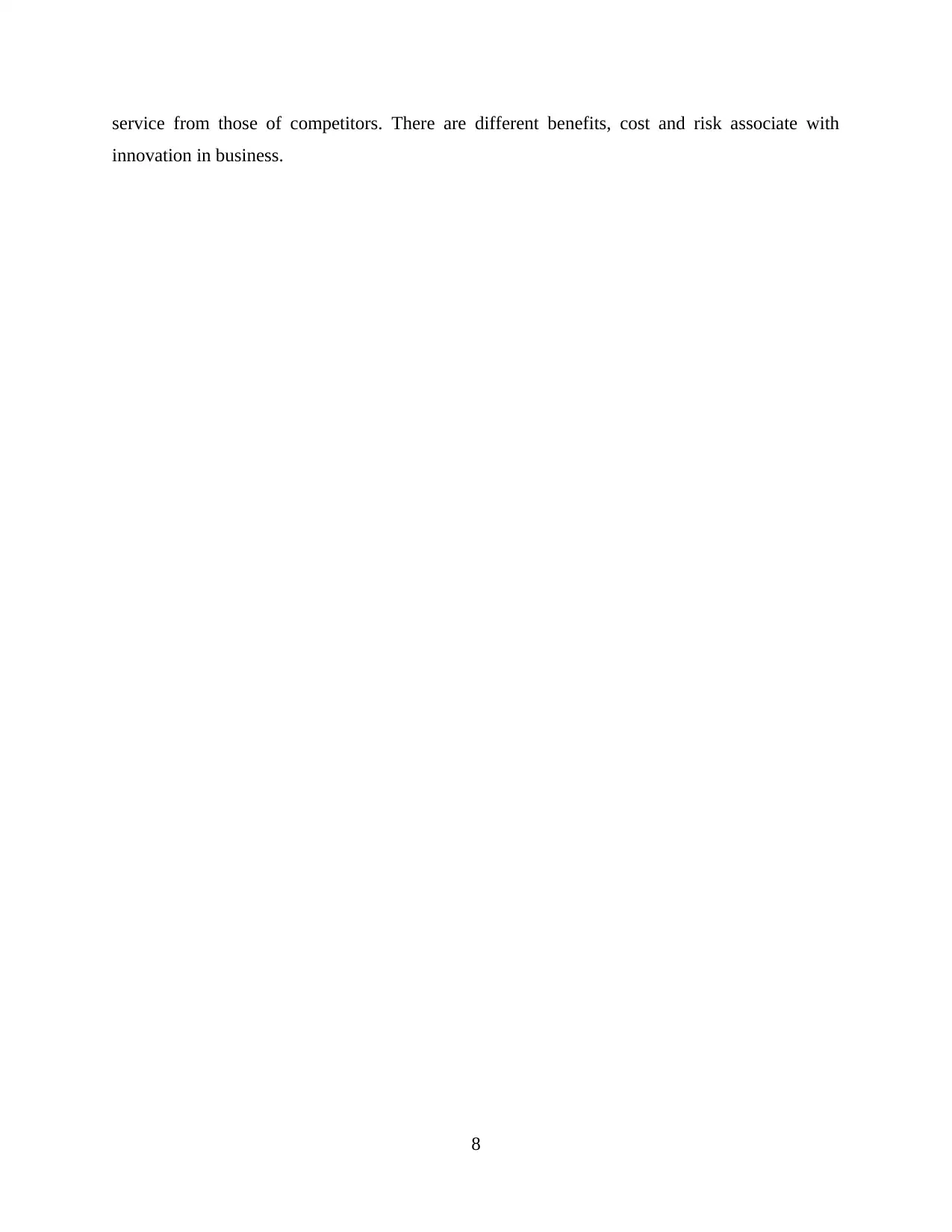
service from those of competitors. There are different benefits, cost and risk associate with
innovation in business.
8
innovation in business.
8
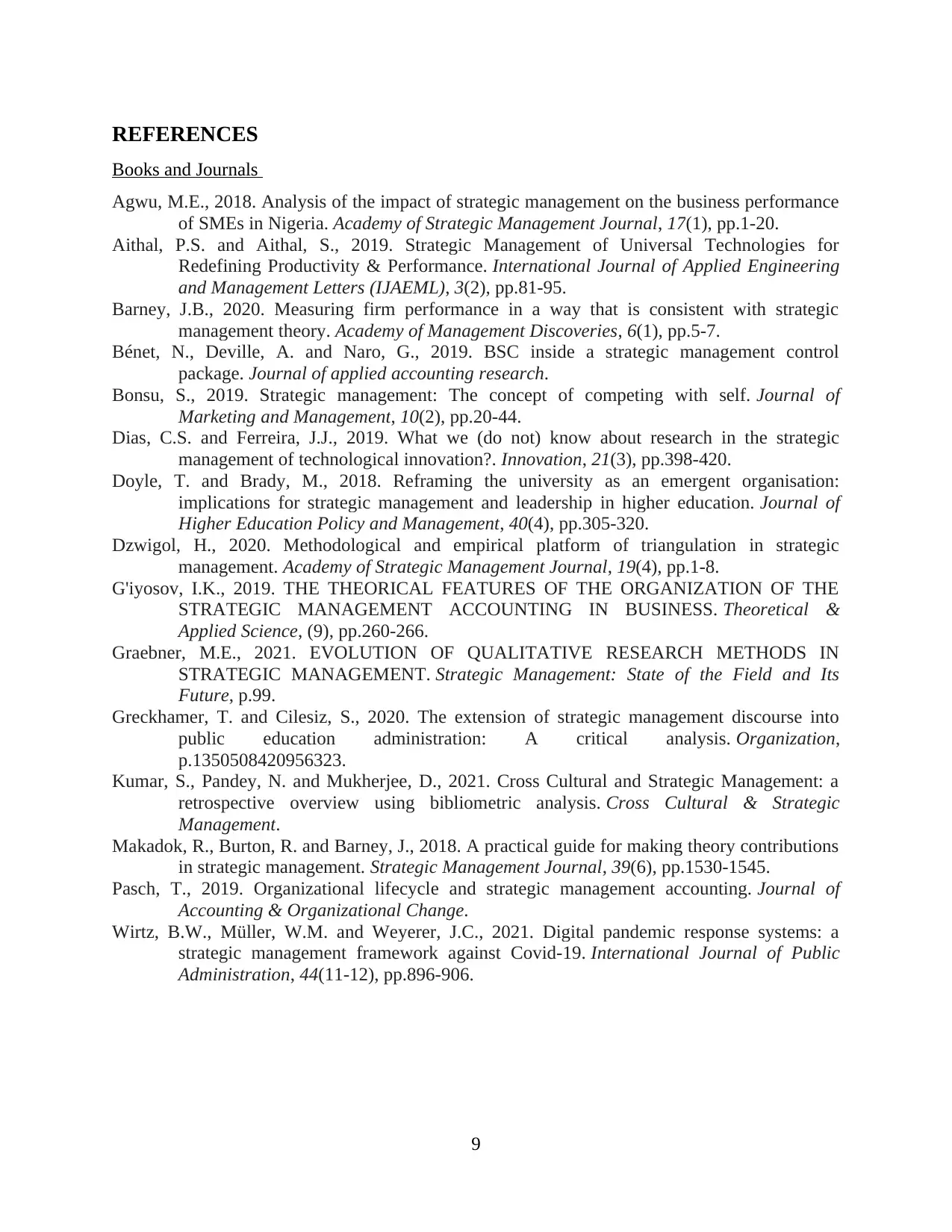
REFERENCES
Books and Journals
Agwu, M.E., 2018. Analysis of the impact of strategic management on the business performance
of SMEs in Nigeria. Academy of Strategic Management Journal, 17(1), pp.1-20.
Aithal, P.S. and Aithal, S., 2019. Strategic Management of Universal Technologies for
Redefining Productivity & Performance. International Journal of Applied Engineering
and Management Letters (IJAEML), 3(2), pp.81-95.
Barney, J.B., 2020. Measuring firm performance in a way that is consistent with strategic
management theory. Academy of Management Discoveries, 6(1), pp.5-7.
Bénet, N., Deville, A. and Naro, G., 2019. BSC inside a strategic management control
package. Journal of applied accounting research.
Bonsu, S., 2019. Strategic management: The concept of competing with self. Journal of
Marketing and Management, 10(2), pp.20-44.
Dias, C.S. and Ferreira, J.J., 2019. What we (do not) know about research in the strategic
management of technological innovation?. Innovation, 21(3), pp.398-420.
Doyle, T. and Brady, M., 2018. Reframing the university as an emergent organisation:
implications for strategic management and leadership in higher education. Journal of
Higher Education Policy and Management, 40(4), pp.305-320.
Dzwigol, H., 2020. Methodological and empirical platform of triangulation in strategic
management. Academy of Strategic Management Journal, 19(4), pp.1-8.
G'iyosov, I.K., 2019. THE THEORICAL FEATURES OF THE ORGANIZATION OF THE
STRATEGIC MANAGEMENT ACCOUNTING IN BUSINESS. Theoretical &
Applied Science, (9), pp.260-266.
Graebner, M.E., 2021. EVOLUTION OF QUALITATIVE RESEARCH METHODS IN
STRATEGIC MANAGEMENT. Strategic Management: State of the Field and Its
Future, p.99.
Greckhamer, T. and Cilesiz, S., 2020. The extension of strategic management discourse into
public education administration: A critical analysis. Organization,
p.1350508420956323.
Kumar, S., Pandey, N. and Mukherjee, D., 2021. Cross Cultural and Strategic Management: a
retrospective overview using bibliometric analysis. Cross Cultural & Strategic
Management.
Makadok, R., Burton, R. and Barney, J., 2018. A practical guide for making theory contributions
in strategic management. Strategic Management Journal, 39(6), pp.1530-1545.
Pasch, T., 2019. Organizational lifecycle and strategic management accounting. Journal of
Accounting & Organizational Change.
Wirtz, B.W., Müller, W.M. and Weyerer, J.C., 2021. Digital pandemic response systems: a
strategic management framework against Covid-19. International Journal of Public
Administration, 44(11-12), pp.896-906.
9
Books and Journals
Agwu, M.E., 2018. Analysis of the impact of strategic management on the business performance
of SMEs in Nigeria. Academy of Strategic Management Journal, 17(1), pp.1-20.
Aithal, P.S. and Aithal, S., 2019. Strategic Management of Universal Technologies for
Redefining Productivity & Performance. International Journal of Applied Engineering
and Management Letters (IJAEML), 3(2), pp.81-95.
Barney, J.B., 2020. Measuring firm performance in a way that is consistent with strategic
management theory. Academy of Management Discoveries, 6(1), pp.5-7.
Bénet, N., Deville, A. and Naro, G., 2019. BSC inside a strategic management control
package. Journal of applied accounting research.
Bonsu, S., 2019. Strategic management: The concept of competing with self. Journal of
Marketing and Management, 10(2), pp.20-44.
Dias, C.S. and Ferreira, J.J., 2019. What we (do not) know about research in the strategic
management of technological innovation?. Innovation, 21(3), pp.398-420.
Doyle, T. and Brady, M., 2018. Reframing the university as an emergent organisation:
implications for strategic management and leadership in higher education. Journal of
Higher Education Policy and Management, 40(4), pp.305-320.
Dzwigol, H., 2020. Methodological and empirical platform of triangulation in strategic
management. Academy of Strategic Management Journal, 19(4), pp.1-8.
G'iyosov, I.K., 2019. THE THEORICAL FEATURES OF THE ORGANIZATION OF THE
STRATEGIC MANAGEMENT ACCOUNTING IN BUSINESS. Theoretical &
Applied Science, (9), pp.260-266.
Graebner, M.E., 2021. EVOLUTION OF QUALITATIVE RESEARCH METHODS IN
STRATEGIC MANAGEMENT. Strategic Management: State of the Field and Its
Future, p.99.
Greckhamer, T. and Cilesiz, S., 2020. The extension of strategic management discourse into
public education administration: A critical analysis. Organization,
p.1350508420956323.
Kumar, S., Pandey, N. and Mukherjee, D., 2021. Cross Cultural and Strategic Management: a
retrospective overview using bibliometric analysis. Cross Cultural & Strategic
Management.
Makadok, R., Burton, R. and Barney, J., 2018. A practical guide for making theory contributions
in strategic management. Strategic Management Journal, 39(6), pp.1530-1545.
Pasch, T., 2019. Organizational lifecycle and strategic management accounting. Journal of
Accounting & Organizational Change.
Wirtz, B.W., Müller, W.M. and Weyerer, J.C., 2021. Digital pandemic response systems: a
strategic management framework against Covid-19. International Journal of Public
Administration, 44(11-12), pp.896-906.
9
⊘ This is a preview!⊘
Do you want full access?
Subscribe today to unlock all pages.

Trusted by 1+ million students worldwide
1 out of 12
Related Documents
Your All-in-One AI-Powered Toolkit for Academic Success.
+13062052269
info@desklib.com
Available 24*7 on WhatsApp / Email
![[object Object]](/_next/static/media/star-bottom.7253800d.svg)
Unlock your academic potential
Copyright © 2020–2025 A2Z Services. All Rights Reserved. Developed and managed by ZUCOL.





